Lateral Confinement Reinforcement of Timber Under Perpendicular-to-Grain Compression
Abstract
1. Introduction
- A.
- Elastic segment: wood displays elastic behavior, which remains linear over the entire range except at the terminal segment.
- B.
- Plastic segment: buckling of the cell walls and thus yielding of the fibres with macroscopically evident crushing under a small load increase.
- C.
- Hardening segment: the cell walls break, occupying the empty cell lumen, causing the fibres to accumulate and densify, thereby increasing the strength of the whole. The increase in strength continues until the fibres finally break under compression (around 225 MPa for Picea abies [18]).
2. Materials and Methods
2.1. Materials
2.2. Methods
- EL: 11,500 MPa, ER: 300 MPa, ET: 300 MPa
- GLR: 650 MPa, GLT: 650 MPa, GRT: 65 MPa
- ʋLR: 0.372, ʋLT: 0.467, ʋRT: 0.435
- ʋRL: 0.010, ʋTL: 0.012, ʋTR: 0.435
3. Results and Discussions
3.1. Initial Reinforcement
3.2. Enhanced Reinforcement
4. Conclusions
Author Contributions
Funding
Data Availability Statement
Acknowledgments
Conflicts of Interest
Correction Statement
Abbreviations
| FE | Finite Element |
| LVDT | Linear Variable Displacement Transducer |
| LVL | Laminated Veneer Lumber |
References
- Leijten, A.J.M.; Franke, S.; Quenneville, P.; Gupta, R. Bearing Strength Capacity of Continuous Supported Timber Beams: Unified Approach for Test Methods and Structural Design Codes. J. Struct. Eng. 2012, 138, 266–272. [Google Scholar] [CrossRef]
- Hassan, K.A.; Hussain, T.; Arman, K. Compression Perpendicular to Grain in Timber-Bearing Strength for a Sill Plate. Master’s Thesis, Linnaeus University, Växjö, Sweden, 2014. [Google Scholar]
- Brol, J.; Kubica, J.; Weglorz, M. The Problem of Compressive Strength in Direction Perpendicular to the Grains on Example of Tests of the Load-Bearing Capacity of the Continuously Supported Timber-Frame Sill Plates. Materials 2020, 13, 1160. [Google Scholar] [CrossRef] [PubMed]
- Dietsch, P.; Brandner, R. Self-tapping screws and threaded rods as reinforcement for structural timber elements-A state-of-the-art report. Constr. Build. Mater. 2015, 97, 78–89. [Google Scholar] [CrossRef]
- Harte, A.M.; Dietsch, P. Reinforcement of Timber Structures: A State-of-the-Art Report; Shaker Verlag GmbH: Düren, Germany, 2015. [Google Scholar]
- Dietsch, P.; Rodemeier, S.; Blaß, H.J. Transmission of perpendicular to grain forces using self-tapping screws. In Proceedings of the INTER International Conference on Timber Engineering Research, Tacoma, WA, USA, 26–29 August 2019. [Google Scholar]
- Aloisio, A.; Ussher, E.; Fragiacomo, M.; Tomasi, R. Capacity models for timber under compression perpendicular to grain with screw reinforcement. Eur. J. Wood Wood Prod. 2023, 81, 633–654. [Google Scholar] [CrossRef]
- Tomasi, R.; Aloisio, A.; Hånde, E.A.; Thunberg, K.R.; Ussher, E. Experimental investigation on screw reinforcement of timber members under compression perpendicular to the grain. Eng. Struct. 2023, 275, 115163. [Google Scholar] [CrossRef]
- Kanagaki, D.; Totsuka, M.; Hirashima, T.; Kato, H. Reinforcement for compression perpendicular to grain in column-base and -beam joints using partially threaded and fully threaded screws. Eng. Struct. 2025, 324, 119334. [Google Scholar] [CrossRef]
- Alinoori, F.; Moshiri, F.; Sharafi, P.; Samali, B. Reinforcement methods for compression perpendicular to grain in top/bottom plates of light timber frames. Constr. Build. Mater. 2020, 231, 116377. [Google Scholar] [CrossRef]
- O’Ceallaigh, C.; Conway, M.; Mehra, S.; Harte, A.M. Modified wood as compression reinforcement of timber perpendicular to the grain. In Proceedings of the WCTE 20-21, Santiago, Chile, 9–12 August 2021. [Google Scholar]
- Conway, M.; Mehra, S.; Harte, A.M.; O’Ceallaigh, C. Densified wood dowel reinforcement of timber perpendicular to the grain: A pilot study. J. Struct. Integr. Maint. 2021, 6, 177–186. [Google Scholar] [CrossRef]
- O’Ceallaigh, C.; Conway, M.; Mehra, S.; Harte, A.M. Numerical Investigation of Reinforcement of Timber Elements in Compression Perpendicular to the Grain using Densified Wood Dowels. Constr. Build. Mater. 2021, 288, 122990. [Google Scholar] [CrossRef]
- Verbist, M.; Branco, J.M.; Nunes, L. Characterization of the Mechanical Performance in Compression Perpendicular to the Grain of Insect-Deteriorated Timber. Buildings 2020, 10, 14. [Google Scholar] [CrossRef]
- Pasca, D.P.; Massaro, F.M.; De Santis, Y.; Stamatopoulos, H.; Ljungdahl, J.; Aloisio, A. Deformation level and specimen geometry in compression perpendicular to the grain of solid timber, GLT and CLT timber products. Eng. Struct. 2024, 321, 118972. [Google Scholar] [CrossRef]
- Adibaskoro, T.; Sołowski, W.; Hostikka, S. Experimental dataset for the macro-scale compression of Norway Spruce perpendicular to grain direction. Data Brief 2022, 40, 107742. [Google Scholar] [CrossRef] [PubMed]
- Li, W.; Zhang, Z.; Wang, X.; Mei, C.; Van Acker, J.; Van den Bulcke, J. Understanding the effect of growth ring orientation on the compressive strength perpendicular to the grain of thermally treated wood. Wood Sci. Technol. 2021, 55, 1439–1456. [Google Scholar] [CrossRef]
- Adusumalli, R.B.; Raghavan, R.; Ghisleni, R.; Zimmermann, T.; Michler, J. Deformation and failure mechanism of secondary cell wall in Spruce late wood. Appl. Phys. A Mater. Sci. Process. 2010, 100, 447–452. [Google Scholar] [CrossRef]
- Wu, G.F.; Sun, J.C.; Fu, F.; Ren, H.Q. Review of mechanical behavior of wood under compression load perpendicular-to-grain. Chin. J. Wood Sci. Technol. 2022, 36, 1–8. [Google Scholar] [CrossRef]
- Zhong, Y.; Wu, G.; Fu, F.; Shen, Y.; Sun, J.; Ren, H.; Guo, J. A novel constitutive model for the porosity related super-large deformation and anisotropic behavior of wood under perpendicular to grain compression. Wood Sci. Technol. 2022, 56, 553–571. [Google Scholar] [CrossRef]
- EN 14080; Timber Structures—Glued Laminated Timber and glued Solid Timber—Requirements. European Committee for Standarization (CEN): Brussels, Belgium, 2013.
- EN 408:2010+A1; Timber Structures—Structural Timber and Glued Laminated Timber—Determination of Some Physical and Mechanical Properties. European Committee for Standardization (CEN): Brussels, Belgium, 2012.
- Kretschmann, D.E. Chapter 5: Mechanical properties of wood. In Wood Handbook: Wood as an Engineering Material; General technical Report FPL-GTR-190; United States Department of Agriculture (USDA), Forest Product Laboratory: Madison, WI, USA, 2010. [Google Scholar]
- Sudo, R.; Miyamoto, K.; Ido, H. Quantitative assessment of adhesive effects on partial and full compressive strength of LVL in the edge-wise direction. J. Wood Sci. 2025, 71, 19. [Google Scholar] [CrossRef]
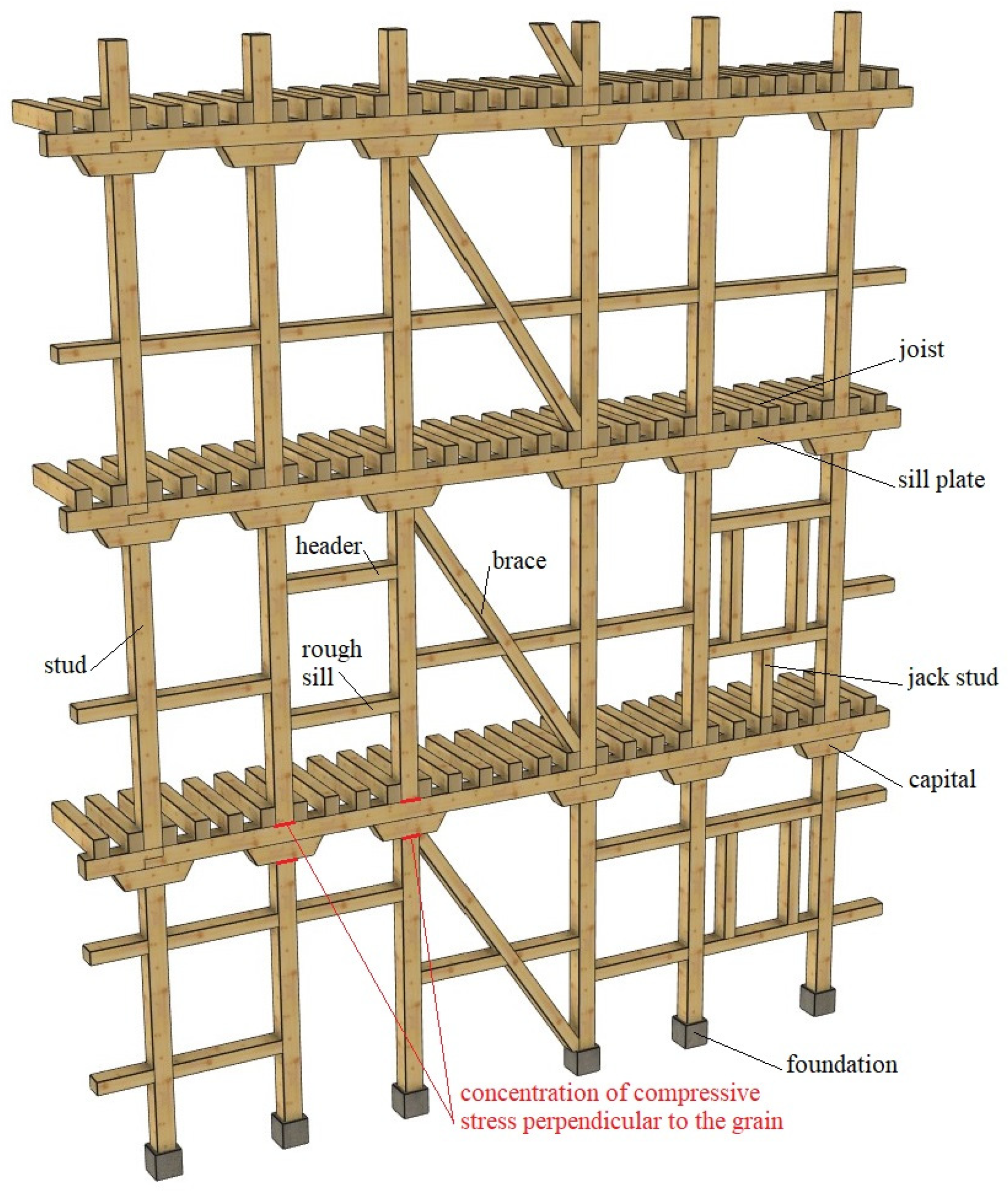

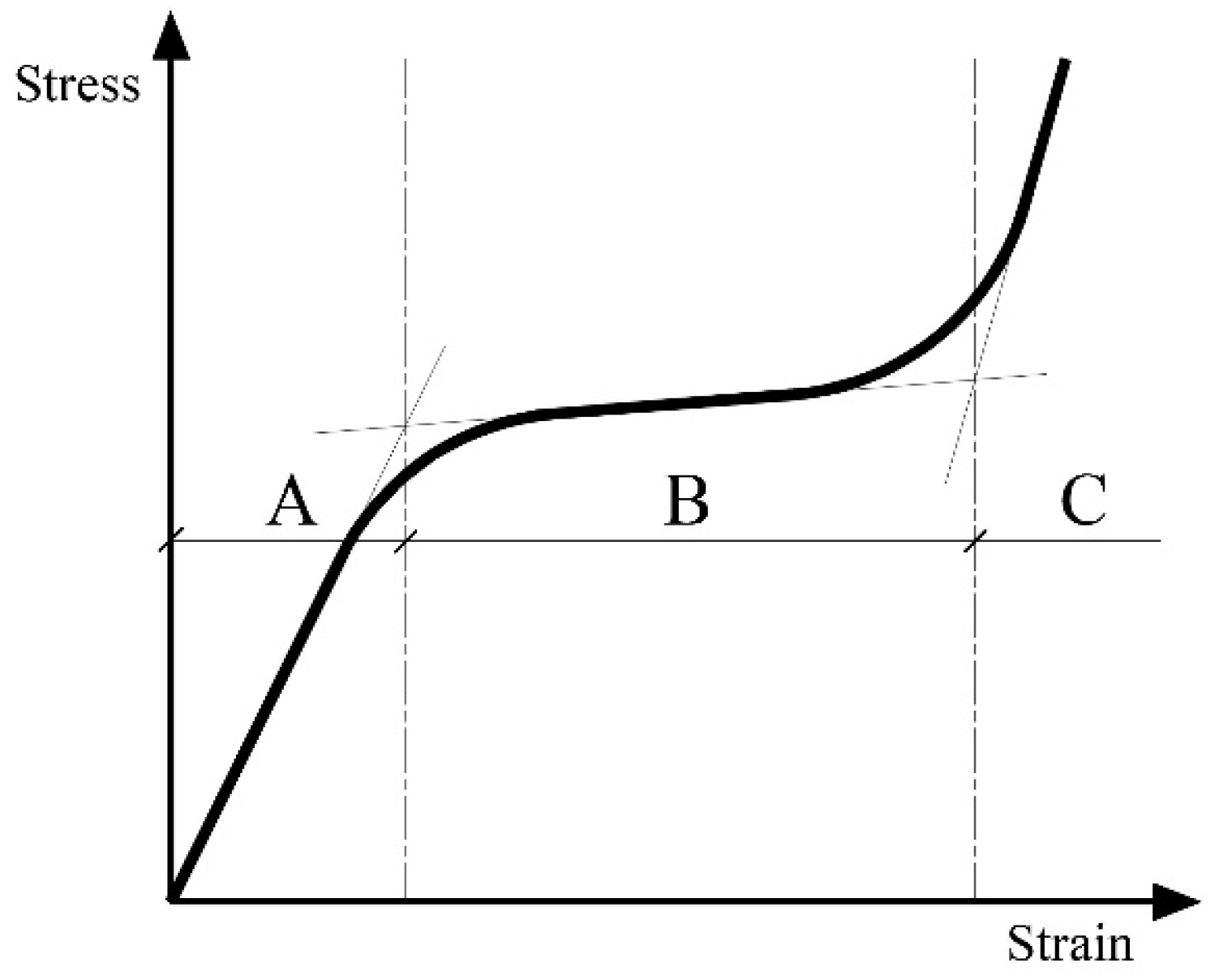
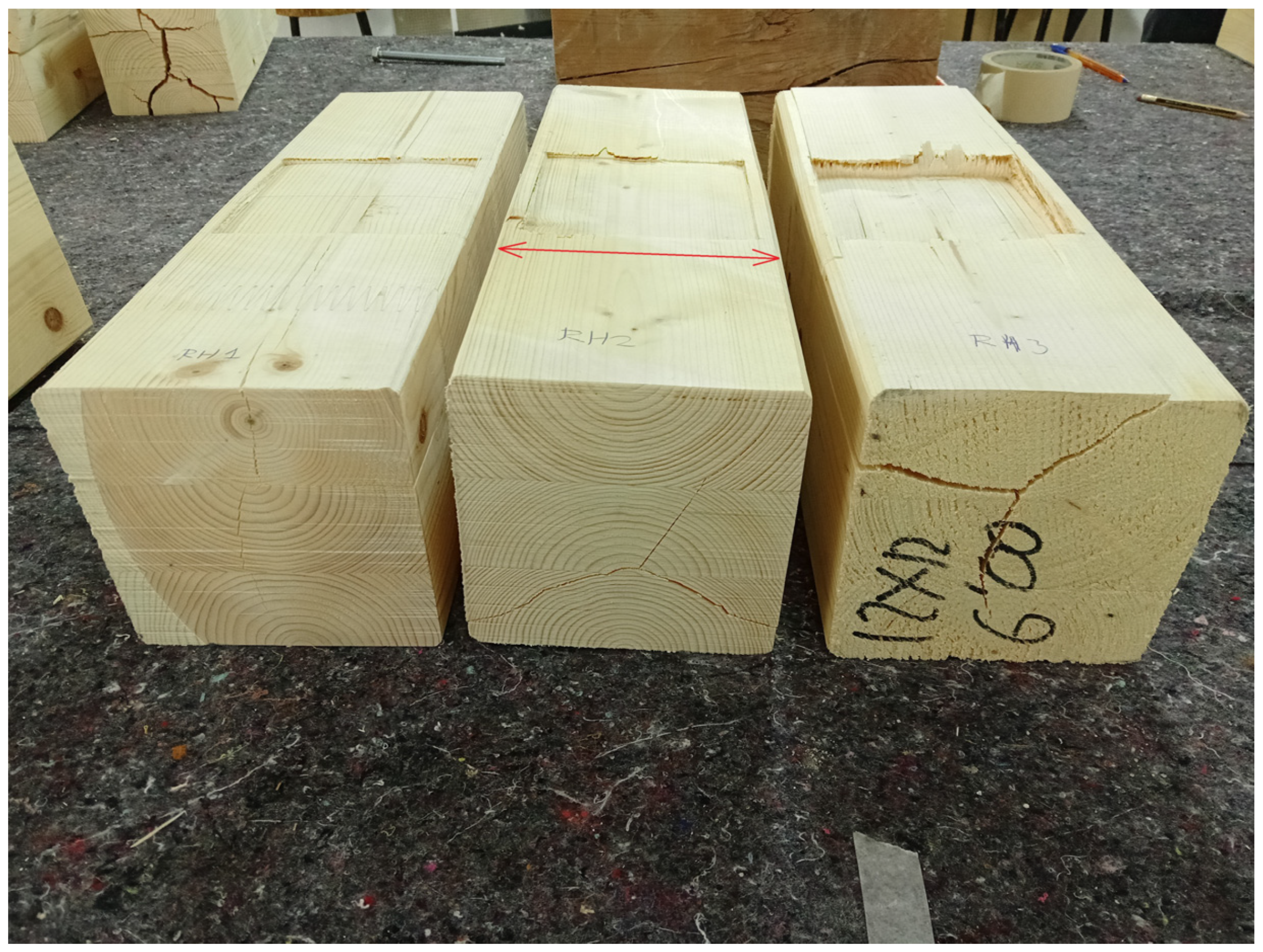
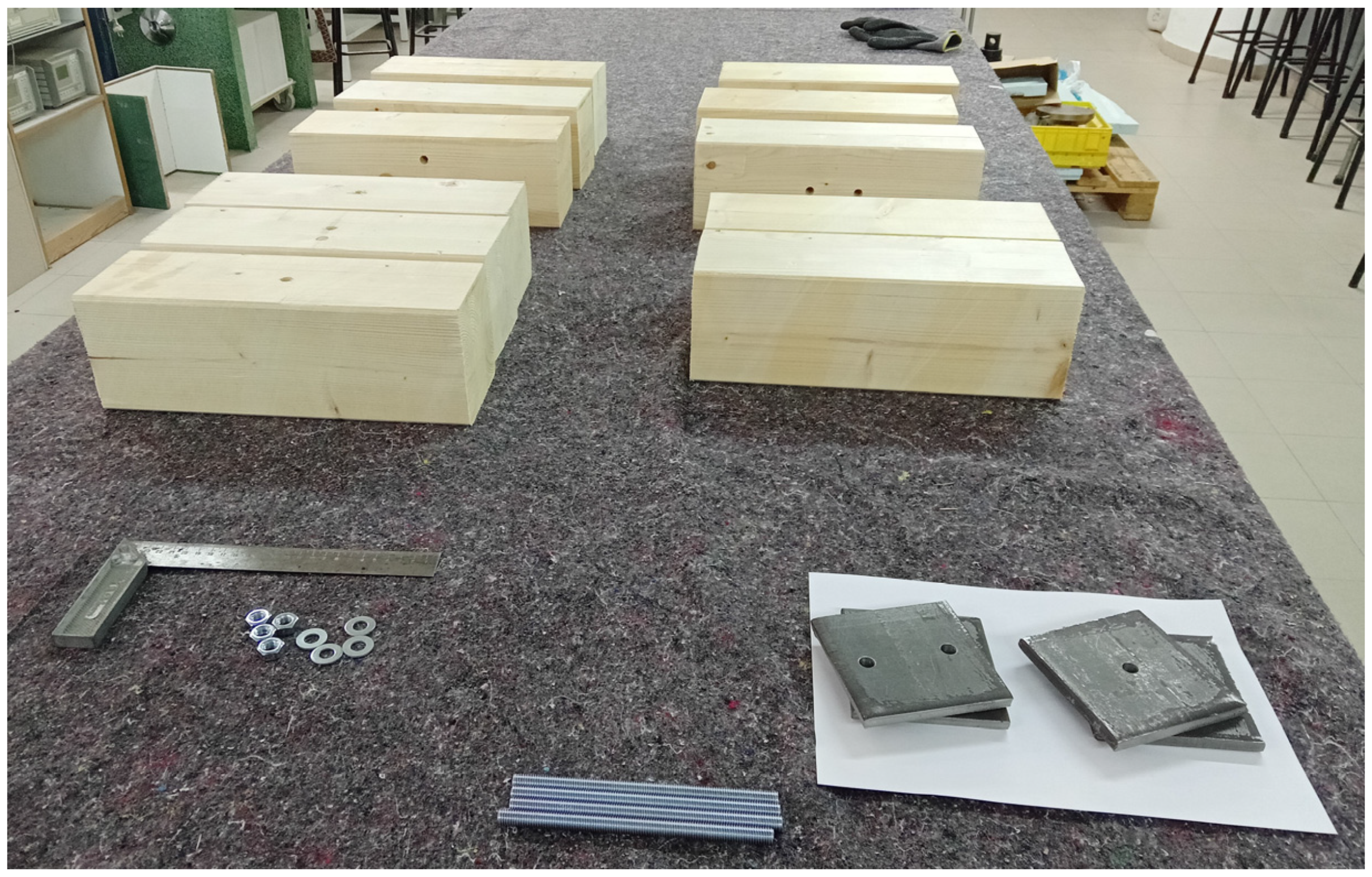
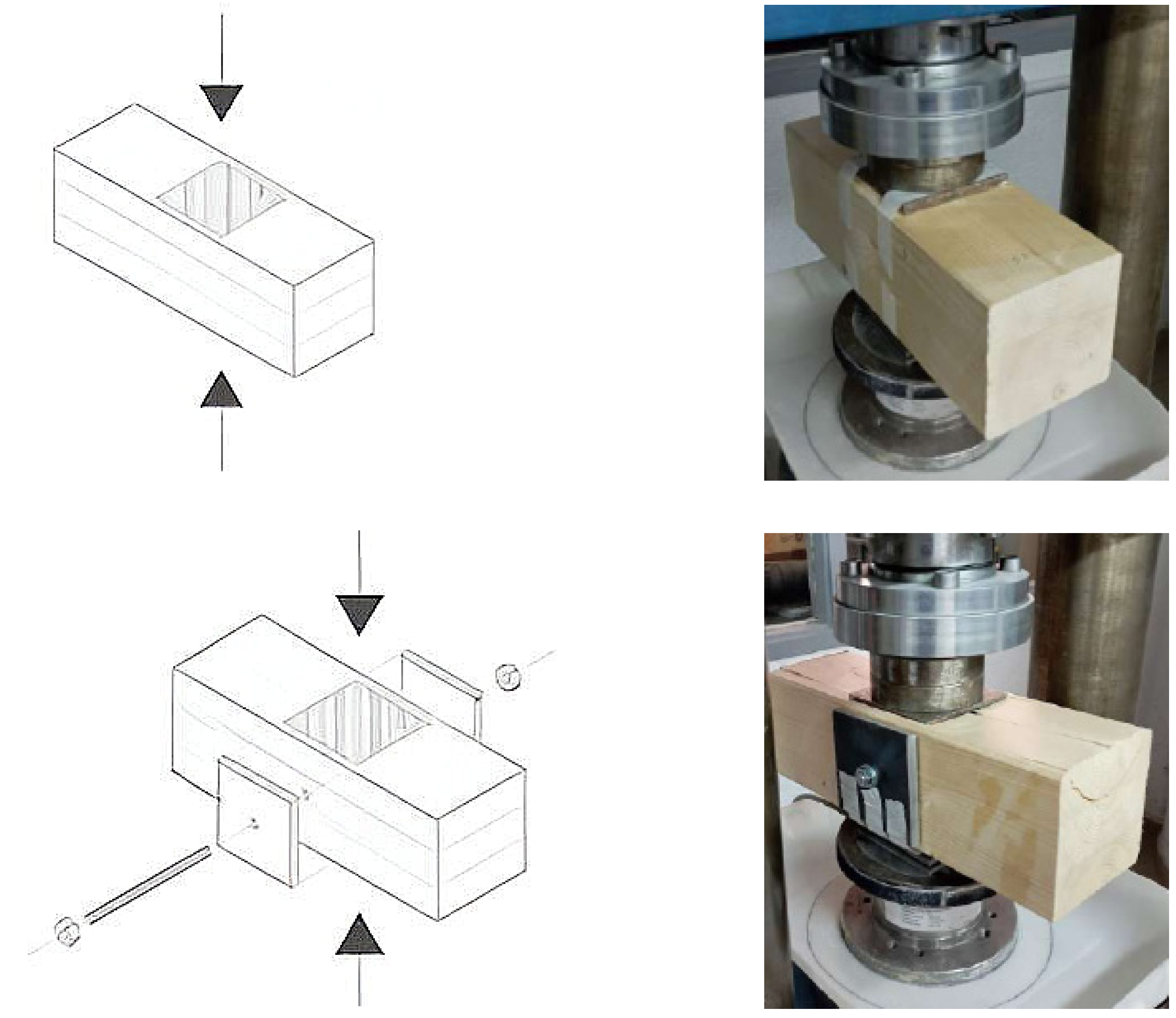
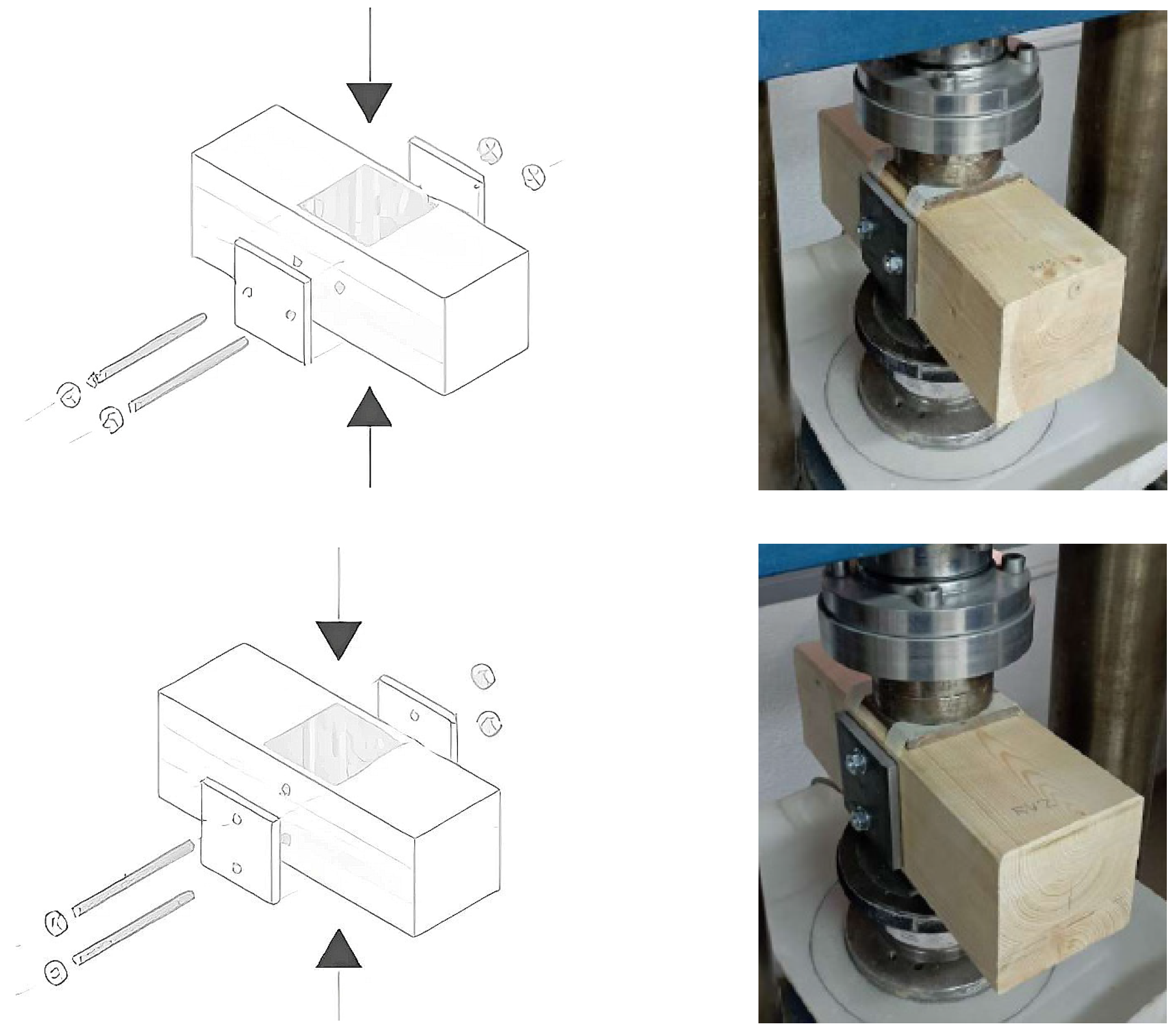
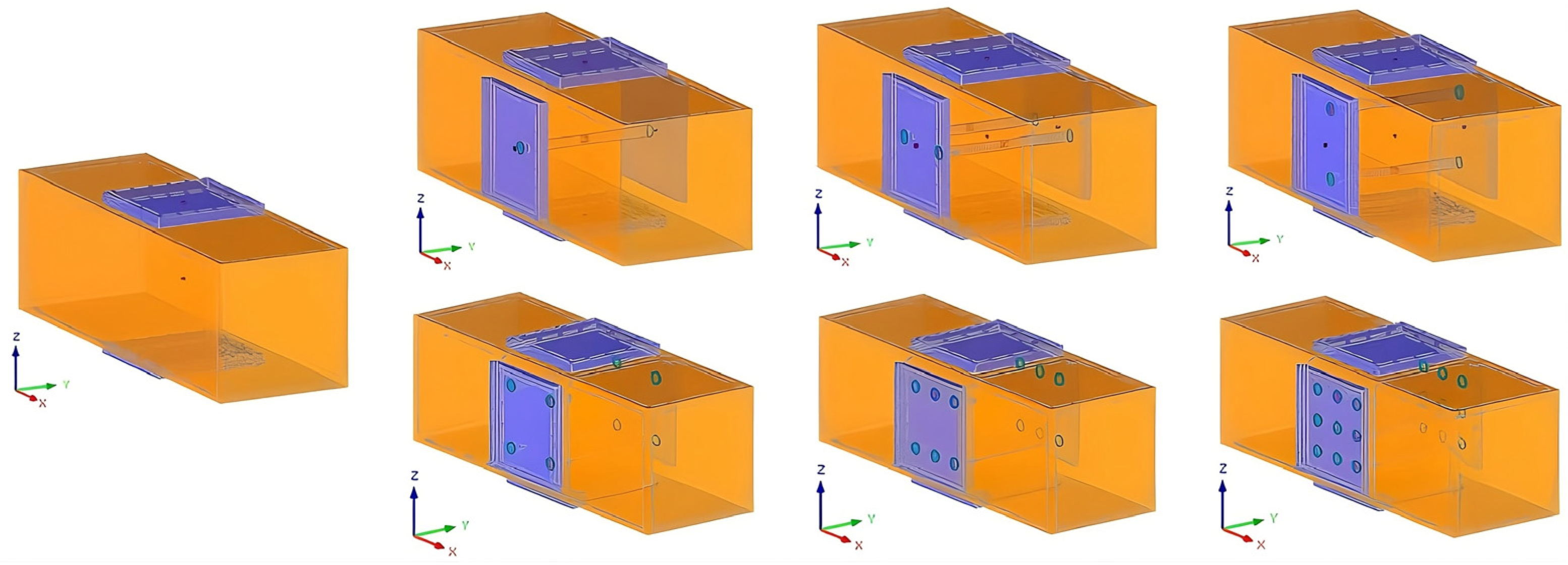

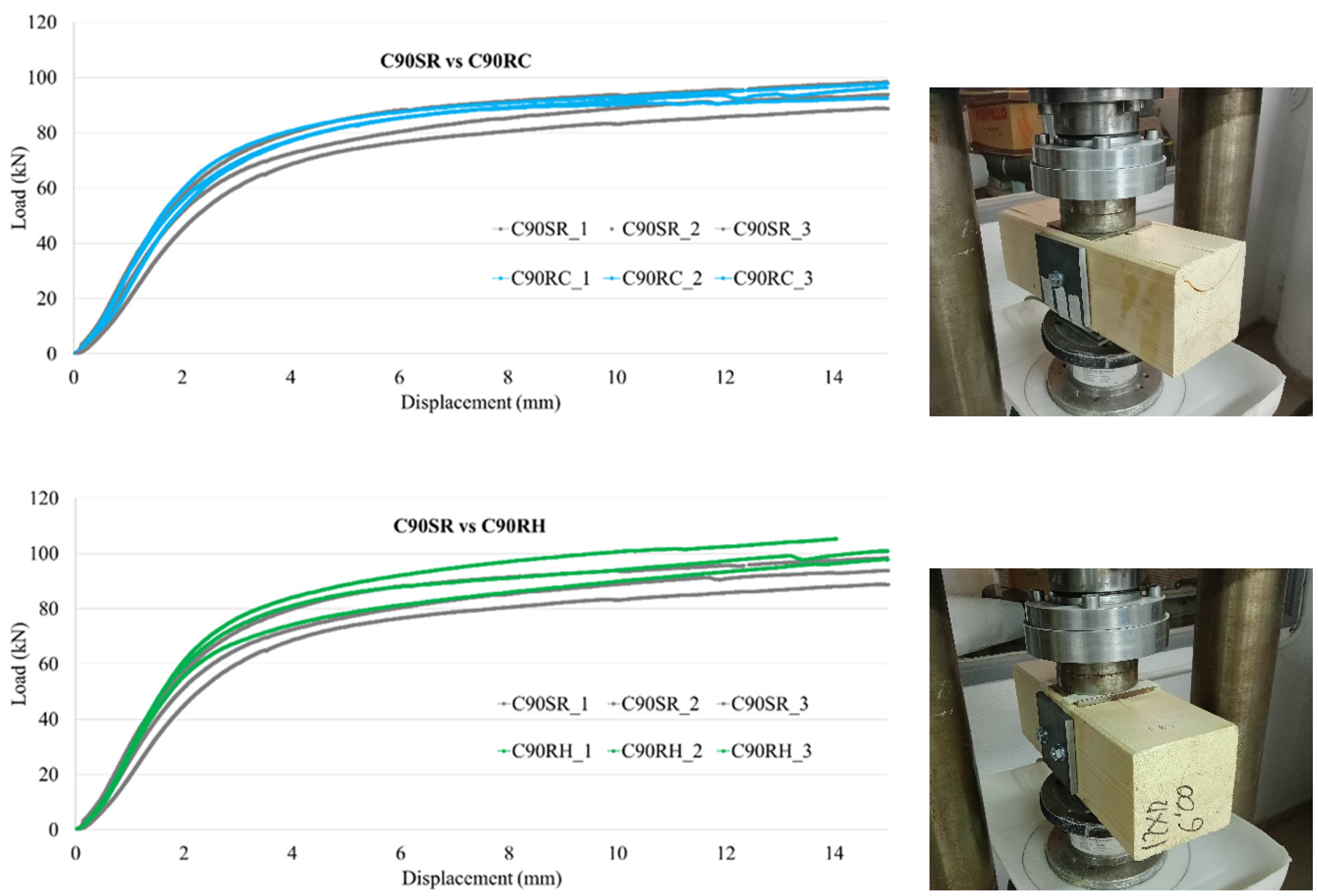

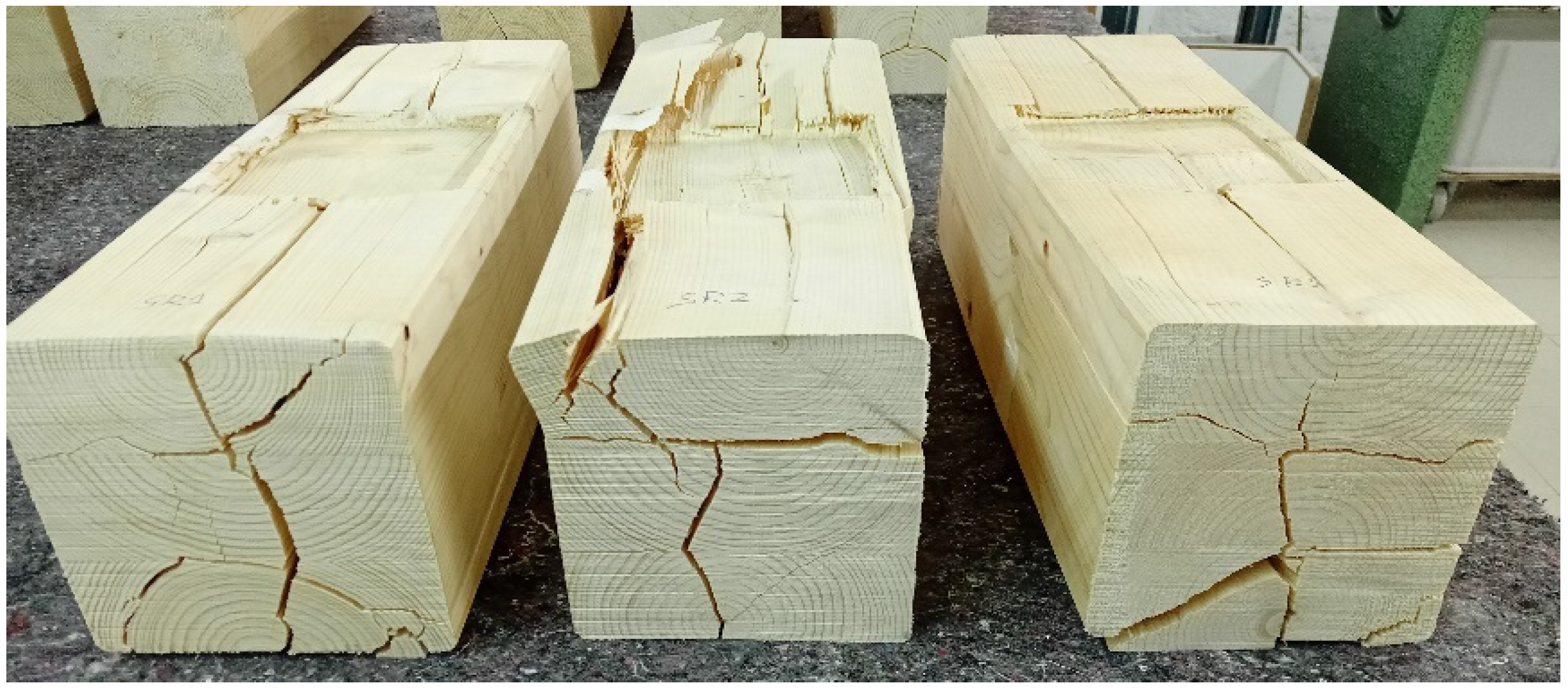

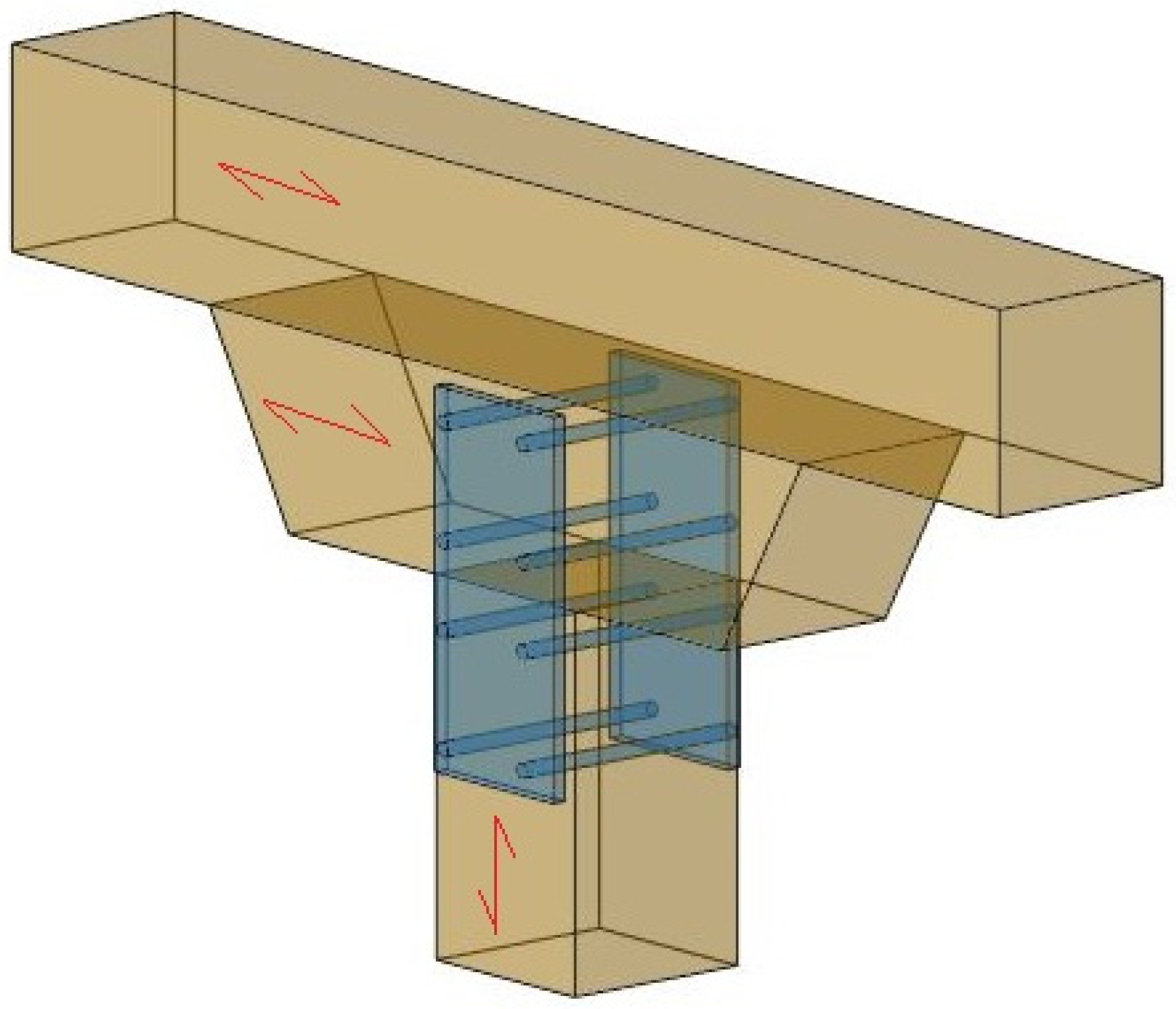
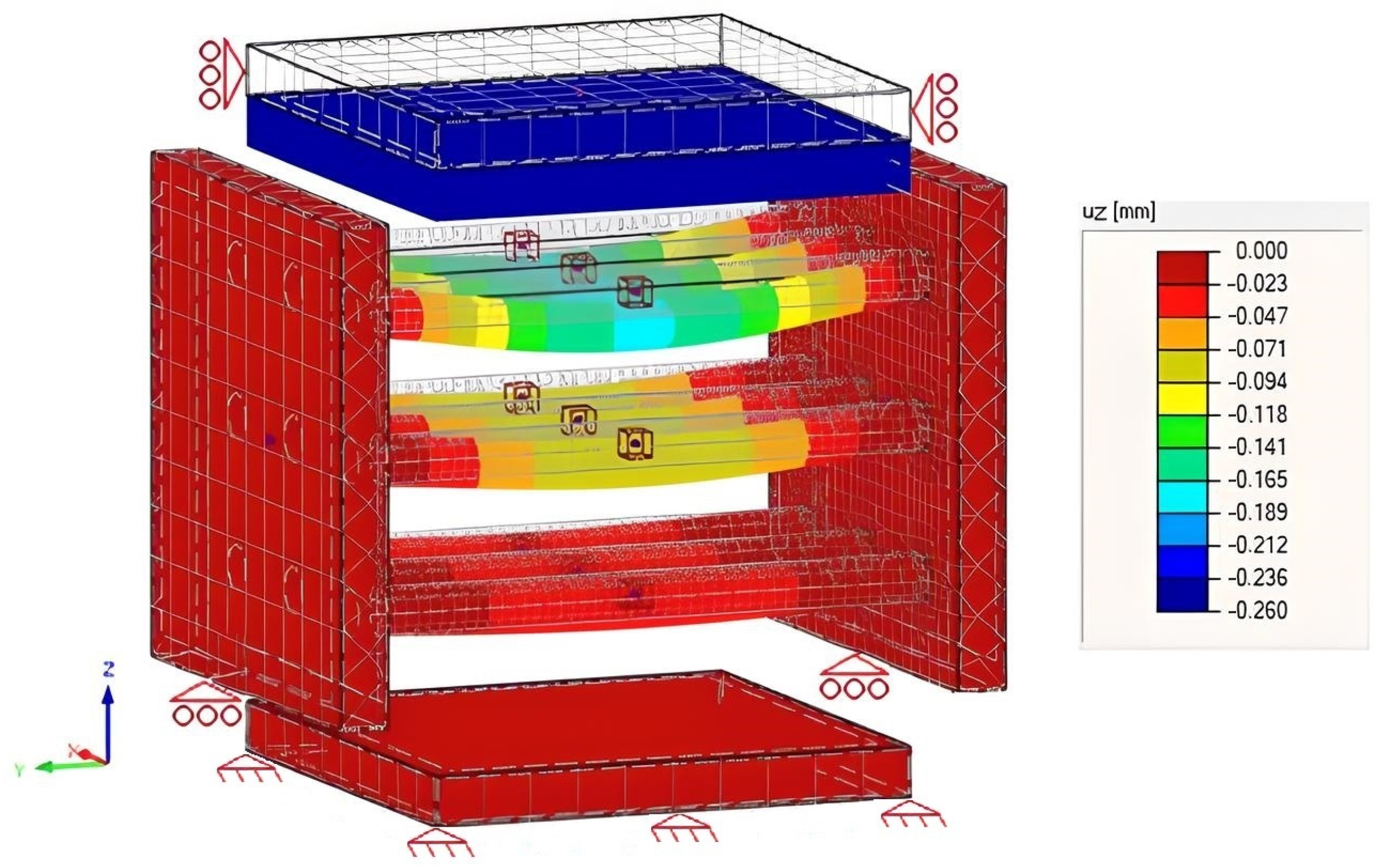
| Test Type | Experimental Results (Side Plates No Fixed to the Lower Column) | FE Results (Side Plates No Fixed to the Lower Column) | ||
|---|---|---|---|---|
| crushing (mm) | crush reduction (%) | crushing (mm) | crush reduction (%) | |
| C90SR | 0.495 | --- | 0.415 | --- |
| C90RC | 0.439 | 11 | 0.367 | 12 |
| C90RH | 0.436 | 12 | 0.362 | 13 |
| C90RV | 0.394 | 20 | 0.341 | 18 |
| C904P | --- | --- | 0.330 | 20 |
| C906P | --- | --- | 0.318 | 23 |
| C909P | --- | --- | 0.309 | 26 |
| Test Type | FE Results (Side Plates Fixed to the Lower Stud) | |
|---|---|---|
| crushing (mm) | crush reduction (%) | |
| C90SR | 0.415 | --- |
| C90RC | 0.287 | 31 |
| C90RH | 0.269 | 35 |
| C90RV | 0.256 | 38 |
| C904P | 0.226 | 46 |
| C906P | 0.208 | 50 |
| C909P | 0.193 | 53 |
| C90RC | C90RH | C90RV | C904P | C906P | C909P | ||||||
|---|---|---|---|---|---|---|---|---|---|---|---|
| Central bolt | Both bolts | Upper bolt | Lower bolt | Upper bolts | Lower bolts | Upper bolts | Lower bolts | Upper bolts | Central bolts | Lower bolts | |
| f (mm) | 0.178 | 0.162 | 0.251 | 0.075 | 0.213 | 0.066 | 0.190 | 0.050 | 0.162 | 0.086 | 0.050 |
| Qreal (N/mm) | 33.98 | 30.93 | 47.91 | 14.32 | 40.66 | 12.60 | 36.27 | 9.54 | 30.93 | 16.42 | 9.54 |
| Qtrib (N/mm) | 19.44 | 19.44 | 19.44 | 19.44 | 19.44 | 19.44 | 19.44 | 19.44 | 19.44 | 19.44 | 19.44 |
| kload | 1.75 | 1.59 | 2.46 | 0.74 | 2.09 | 0.65 | 1.87 | 0.49 | 1.59 | 0.84 | 0.49 |
Disclaimer/Publisher’s Note: The statements, opinions and data contained in all publications are solely those of the individual author(s) and contributor(s) and not of MDPI and/or the editor(s). MDPI and/or the editor(s) disclaim responsibility for any injury to people or property resulting from any ideas, methods, instructions or products referred to in the content. |
© 2025 by the authors. Licensee MDPI, Basel, Switzerland. This article is an open access article distributed under the terms and conditions of the Creative Commons Attribution (CC BY) license (https://creativecommons.org/licenses/by/4.0/).
Share and Cite
Aira-Zunzunegui, J.R.; Gonzalo-Calderón, L. Lateral Confinement Reinforcement of Timber Under Perpendicular-to-Grain Compression. Heritage 2025, 8, 368. https://doi.org/10.3390/heritage8090368
Aira-Zunzunegui JR, Gonzalo-Calderón L. Lateral Confinement Reinforcement of Timber Under Perpendicular-to-Grain Compression. Heritage. 2025; 8(9):368. https://doi.org/10.3390/heritage8090368
Chicago/Turabian StyleAira-Zunzunegui, Jose Ramón, and Laura Gonzalo-Calderón. 2025. "Lateral Confinement Reinforcement of Timber Under Perpendicular-to-Grain Compression" Heritage 8, no. 9: 368. https://doi.org/10.3390/heritage8090368
APA StyleAira-Zunzunegui, J. R., & Gonzalo-Calderón, L. (2025). Lateral Confinement Reinforcement of Timber Under Perpendicular-to-Grain Compression. Heritage, 8(9), 368. https://doi.org/10.3390/heritage8090368







